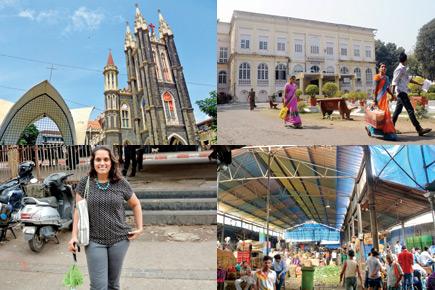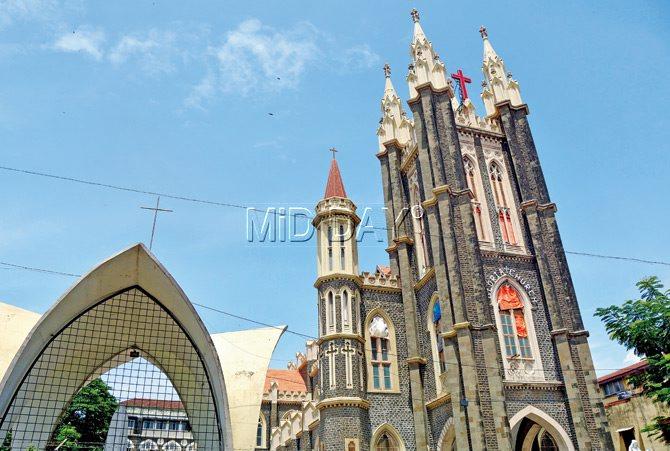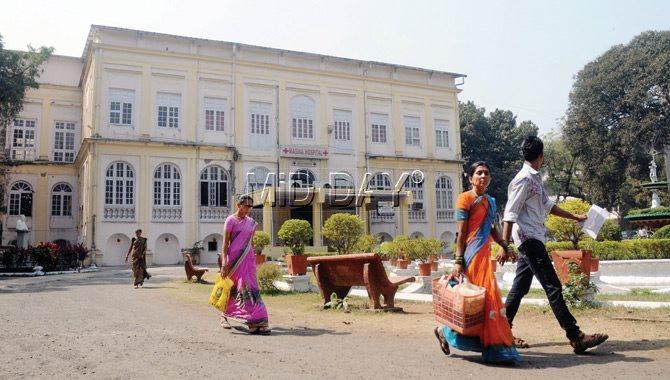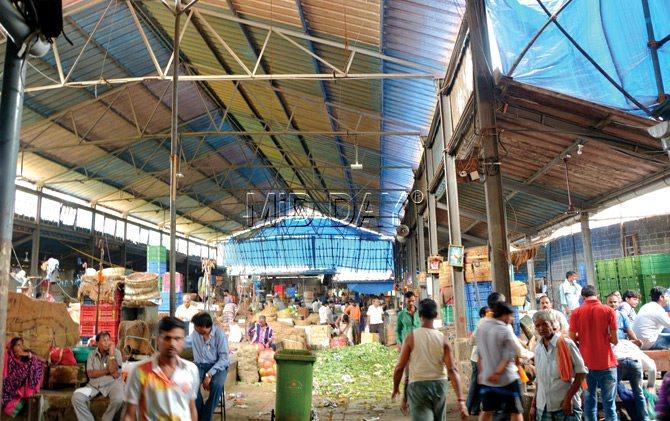With stories dating back to the 1800s, a heritage walk in Byculla will regale you about its past glory with landmarks like Gloria Church, Masina Hospital and Byculla Market for company

![]() It's a grey June morning when we meet heritage expert Alisha Sadikot near the Dr Bhau Daji Lad Museum. Promising to offer a short history lesson of 19th century Byculla, Sadikot gives us a preview of her walk, to be held this weekend, in association with Mumbai Instagrammers.
It's a grey June morning when we meet heritage expert Alisha Sadikot near the Dr Bhau Daji Lad Museum. Promising to offer a short history lesson of 19th century Byculla, Sadikot gives us a preview of her walk, to be held this weekend, in association with Mumbai Instagrammers.

STOP 1: Gloria Church. Pics/ Sayyed Sameer Abedi
STOP 1: Gloria Church
We start at one of Mumbai’s oldest Roman Catholic churches. “Gloria Church is currently under restoration. Till even 20 years ago, the church towers were the tallest in Byculla, but are now buried among the newer buildings. It is one of the oldest churches in the city, though this building dates to 1912. The church was originally built on Mazagaon island. When the Portuguese took over the seven islands, they established their main fort in Vasai,” she says. To aid governance, they leased out land to religious groups and individuals. Each owner had to cultivate and defend their land. Mazagaon was given to Antonio Pessoa, an army general for perpetuity. His family built a house and a private chapel. That was the original Gloria Church; in the 1500s, it was given to the Franciscans to administer. “The church was rebuilt thrice at the first location and later, in 1900s, when the British ruled Bombay, it was moved to its present location. The idol here is original,” adds Sadikot.
As we gaze at it, Sadikot points out its similarity with other SoBo public buildings. “The black stone that characterises Bombay’s Gothic buildings is called (ironically) blue basalt. This stone was locally available, allowing people to use it. This is built in the Neo-Gothic style. In the late 1800s, the British decided that Bombay would be identified by the Gothic style,” she adds, checking if we could spot any Indian influence in the architecture. “The clay-tiled roof is very Indian. It keeps the roof cool; here, the Gothic style was altered to suit local weather conditions. By doing this, they created a new style called the Bombay Gothic style,” she adds, as we cross the road at the busy signal on Dr Ambedkar Road. “In 1806, this road was one of the few to be widened to 60-feet. The British fort area was congested, and the rich moved to Byculla,” she informs, as we negotiate the crowds and head to our next stop.

STOP 2: Masina Hospital, Sir David Sassoon’s home was known for its landscaped gardens. Pic/Bipin Kokate
Stop 2: Masina hospital
This hospital was once David Sassoon’s home. Sadikot shares how he fled Baghdad with a few family members and arrived in India in 1833 after he heard that the British government was giving religious freedom here. In 1864, when he died, he was the richest man in Bombay. “In the 1800s, people built mansions; Byculla was home to the first social club and the turf club. Sassoon’s business flourished, especially with the opium trade. He built schools, hospitals and funded the Dr Bhau Daji Lad Museum,” shares Sadikot who was previously curator, at the museum.

STOP 3: Alisha Sadikot outside Byculla Railway Station that was built in the 1890s
Stop 3: Byculla station
“Since Byculla achieved the status of where the rich lived, it secured some of the best infrastructure. Built in the 1890s, the station is as old as Bandra station,” she adds. We notice the volume of steel and iron that was needed for the structure. “This was shipped from England. One of those firms from where it was secured had also built the Sydney Harbour Bridge,” reveals Sadikot, sharing that inputs about Byculla Ironworks, its mills and links with the freedom struggle will also be a part of her walk. As the railways were set up, Byculla got its market, our next stop.

STOP 4: Byculla Market
Stop 4: Byculla market
“Soon, Byculla market will be up for redevelopment. Dr Ambedkar got married in this market in 1907. No one was giving him space to hold his wedding, as he was Dalit. The grocers built him a shed. Ambedkar hospital located nearby was the original Elphinstone College where he studied. Lokmanya Tilak was felicitated once,” informs Sadikot. She points out how the market was built opposite to the museum. “When it came up, the area looked different. In 20 years, a lot has changed, and it became more of an island in a working class area,” she concludes.
 Subscribe today by clicking the link and stay updated with the latest news!" Click here!
Subscribe today by clicking the link and stay updated with the latest news!" Click here!









